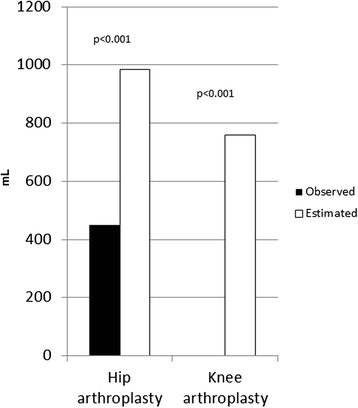Transfusions and blood loss in total hip and knee arthroplasty: a prospective observational study
- PMID: 25889413
- PMCID: PMC4383080
- DOI: 10.1186/s13018-015-0188-6
Transfusions and blood loss in total hip and knee arthroplasty: a prospective observational study
Abstract
Background: There is a high prevalence of blood product transfusions in orthopedic surgery. The reported prevalence of red blood cell transfusions in unselected patients undergoing hip or knee replacement varies between 21% and 70%. We determined current blood loss and transfusion prevalence in total hip and knee arthroplasty when tranexamic acid was used as a routine prophylaxis, and further investigated potential predictors for excessive blood loss and transfusion requirement.
Methods/materials: In total, 193 consecutive patients undergoing unilateral hip (n = 114) or knee arthroplasty (n = 79) were included in a prospective observational study. Estimated perioperative blood loss was calculated and transfusions of allogeneic blood products registered and related to patient characteristics and perioperative variables.
Results: Overall transfusion rate was 16% (18% in hip patients and 11% in knee patients, p = 0.19). Median estimated blood loss was significantly higher in hip patients (984 vs 789 mL, p < 0.001). Preoperative hemoglobin concentration was the only independent predictor of red blood cell transfusion in hip patients while low hemoglobin concentration, body mass index, and operation time were independent predictors for red blood cell transfusion in knee patients.
Conclusions: The prevalence of red blood cell transfusion was lower than previously reported in unselected total hip or knee arthroplasty patients. Routine use of tranexamic acid may have contributed. Low preoperative hemoglobin levels, low body mass index, and long operation increase the risk for red blood cell transfusion.
Figures
References
-
- Rosencher N, Kerkkamp HE, Macheras G, Munuera LM, Menichella G, Barton DM, et al. Orthopedic Surgery Transfusion Hemoglobin European Overview (OSTHEO) study: blood management in elective knee and hip arthroplasty in Europe. Transfusion. 2003;43:459–69. doi: 10.1046/j.1537-2995.2003.00348.x. - DOI - PubMed
Publication types
MeSH terms
Substances
LinkOut - more resources
Full Text Sources
Other Literature Sources
Medical


